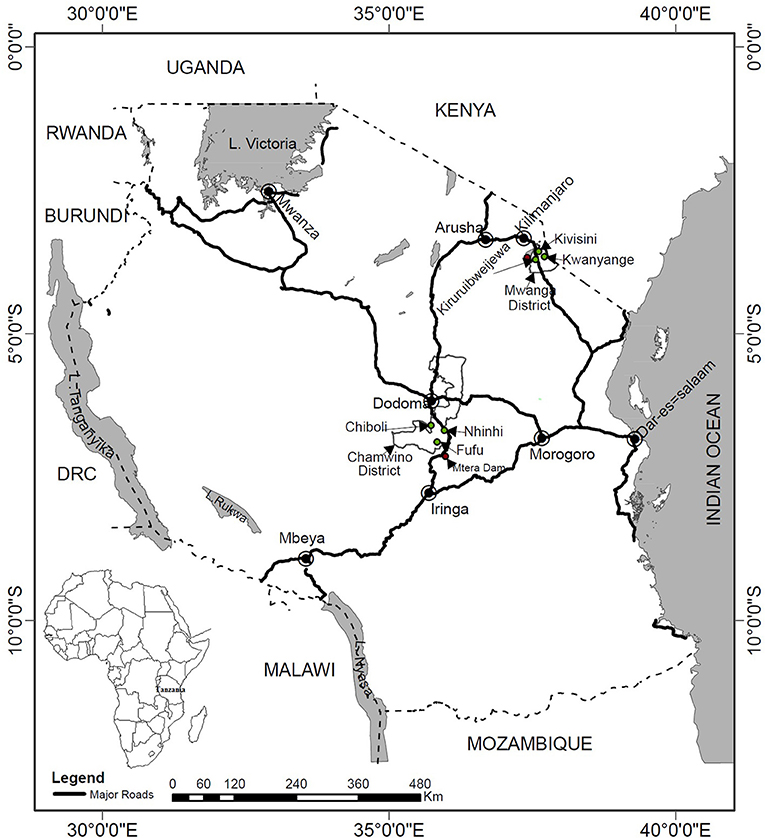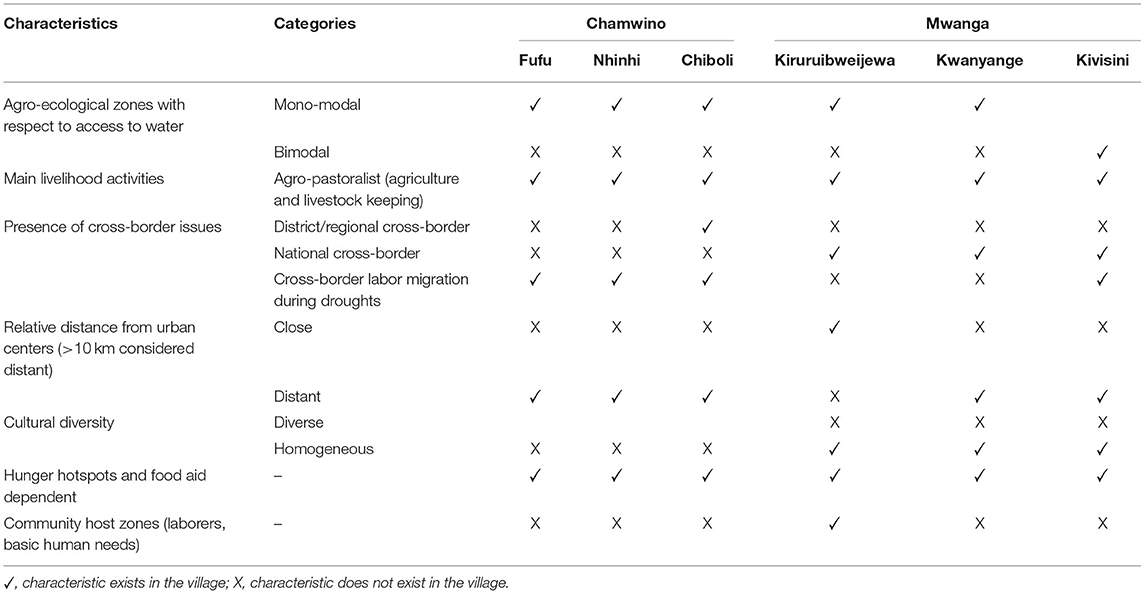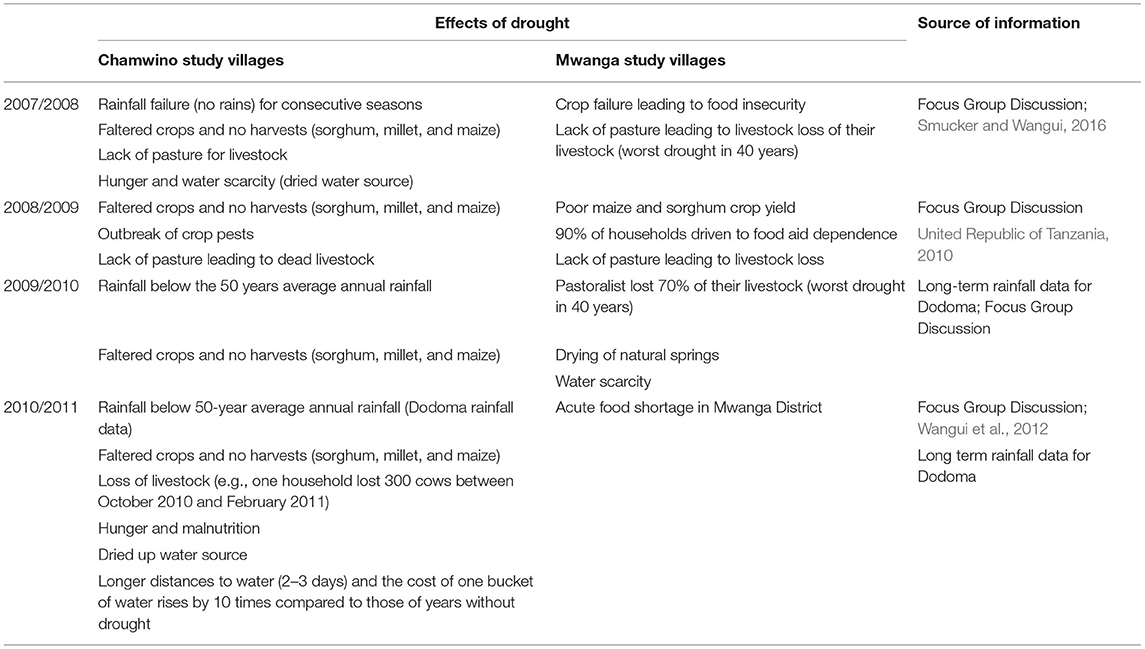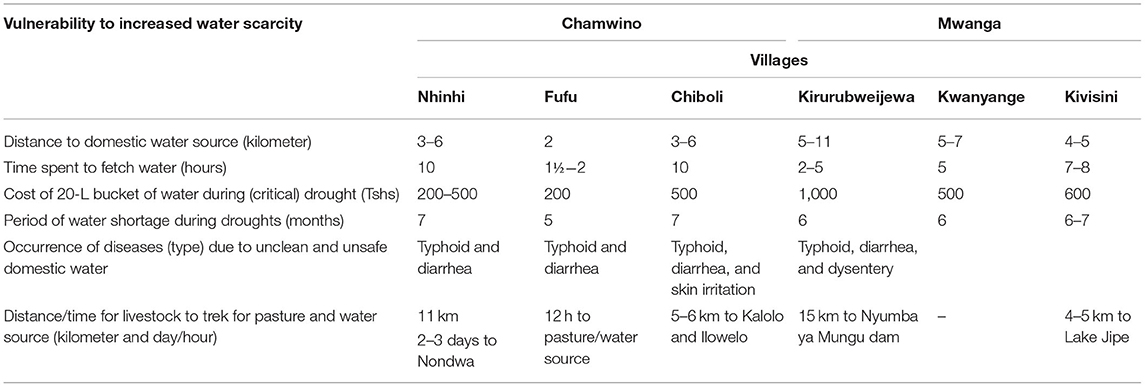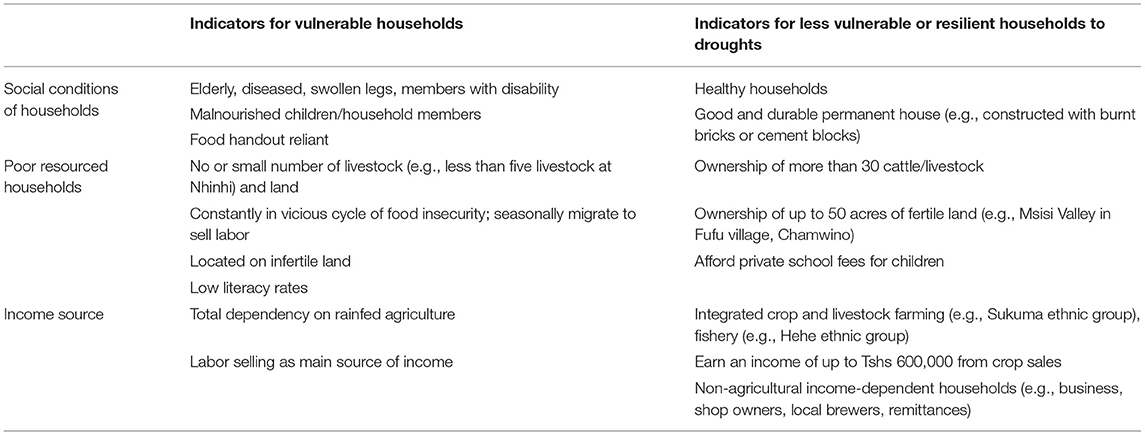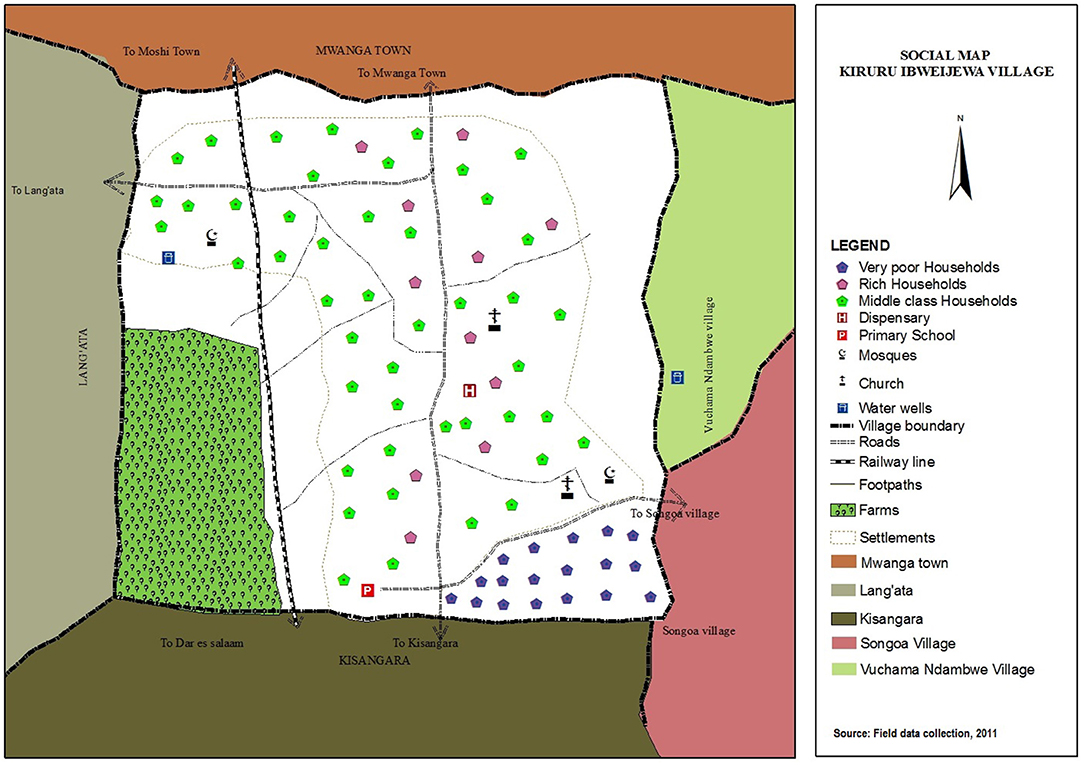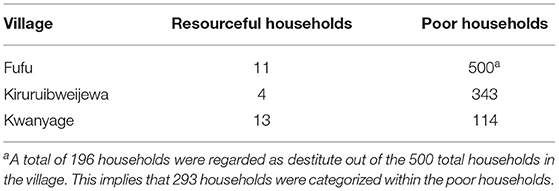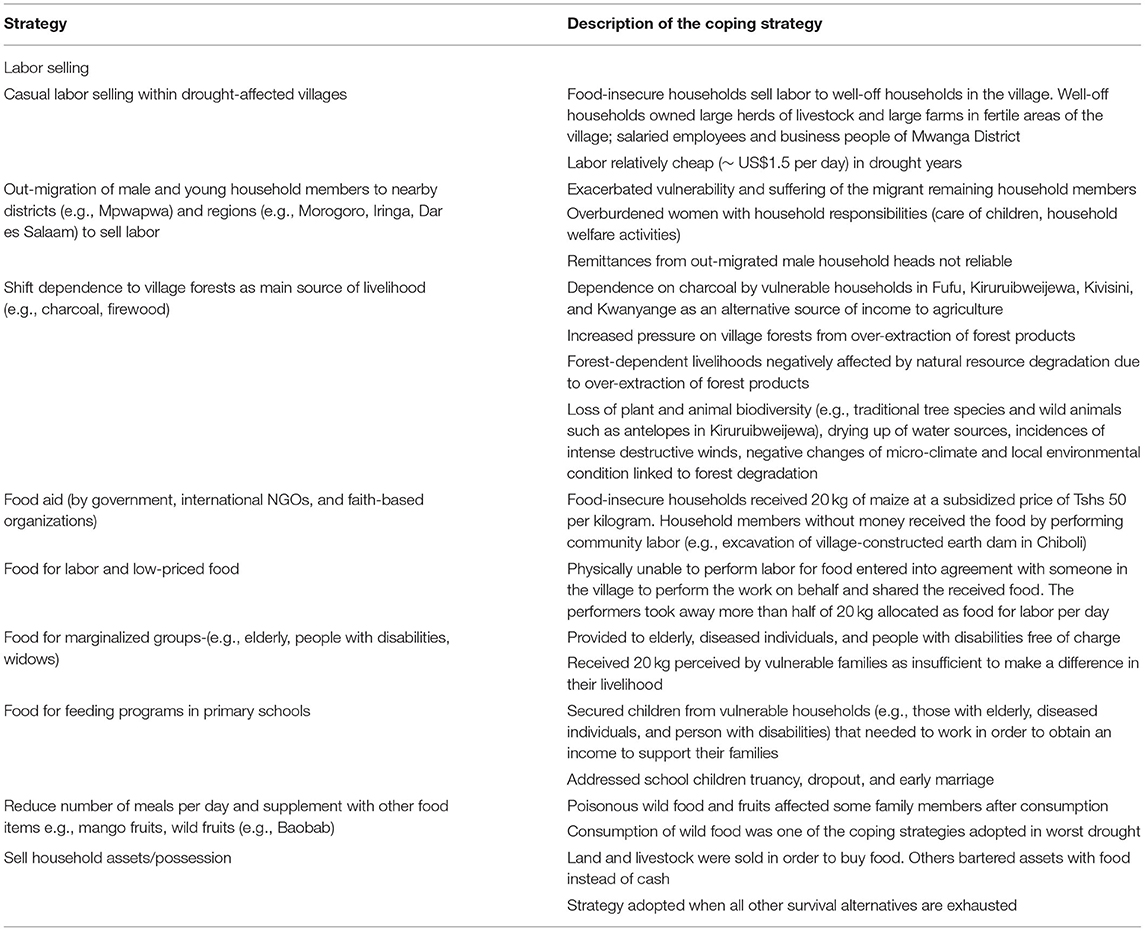- School of Spatial Planning and Social Science, Department of Urban and Regional Planning, Ardhi University, Dar es Salaam, Tanzania
Droughts are one of the most serious threats to water availability, food security, and local livelihoods in the semi-arid areas of Tanzania. This paper adapted the participatory vulnerability assessment tools (causal effects, social mapping–resource mapping–social services–mobility–seasonality) to analyze the effects of prolonged droughts on semi-arid farming systems, community's vulnerability to drought effects, and the adopted coping strategies in six villages of Chamwino and Mwanga districts. Crop failure, loss of pasture, and drying of water sources were the common and major negative effects of droughts. Their consequences included food shortage and insecurity, water scarcity, and loss of livestock. The vulnerability to these effects was found to be driven by the social condition of households, resource ownership, and type of income sources. Those with good social conditions, relatively resourceful and deriving incomes from crop-livestock integration or non-agriculture, were less vulnerable and better placed to cope with the effects of droughts. Investments that build the productive resource base of a household and improve access to domestic and livestock water will contribute to long-term adaptive and drought-resilient systems in semi-arid areas of Tanzania.
Introduction
Frequent and prolonged droughts in the semi-arid areas of Tanzania are an expected phenomenon under current and future climate change and climate variability (Madaha, 2012; Mkonda and He, 2018; Haile et al., 2019). Under higher emission scenarios, 50–70% of the semi-arid areas of Dodoma, Tanzania, are projected to experience high-temperature-induced maize and bean yield decreases due to increased evaporative demands of the land surface and reduced duration of crop growth (Thornton et al., 2009). By 2050, climate change and variability in Tanzania is projected to negatively affect yields for maize, sorghum, and rice by 3.6, 8.9, and 28.6%, respectively (Rowhani et al., 2011). The effects largely will occur as a result of short-duration crop growth contributed by the unpredictable onset and cessation of rain seasons (Mkonda and He, 2018; Zougmoré et al., 2018; Haile et al., 2019). Climate change is also affecting the quantity and quality of water through changes in river basin run-off, increased evaporative demands, and encroachment into the stream ecosystem (Haile et al., 2019). Globally, the availability of freshwater has been predicted to drop by 50% by 2050 due to climate change, while water demand for agriculture could double during the same period (Gupta et al., 2020). These changes will compromise the availability and accessibility of water for domestic and agricultural uses (Haile et al., 2019). Increased food insecurity and water scarcity among vulnerable groups of people in drought-affected areas are two of the typical consequences (Thornton et al., 2009; Madaha, 2012). Vulnerability to drought effects can be influenced by human and social assets, access to technology, and natural capital (Sewando et al., 2016). Access to resources, including land and other natural ecosystems, social assets, community safety nets, and formal and informal institutions (Sewando et al., 2016; Thao et al., 2019; Chepkoecha et al., 2020) can contribute to high adaptive capacity, both at the household and community level. Low adaptive capacity accelerates vulnerability, while the converse strengthens the adaptive capacity (Chepkoecha et al., 2020).
Livelihoods that depend directly on climate-related sectors, such rainfed agriculture, and natural water sources in the semi-arid zones are vulnerable to droughts because of poor crop yield and poverty (Mkonda and He, 2018; Haile et al., 2019). In these zones, droughts may lead to complete crop failure and lack of water, making the livelihoods of people to a difficult aftermath (Oestigaard, 2016; Haile et al., 2019; Thao et al., 2019). Mkonda and He (2018) observed that decreases in rainfall posed effects that ranged from slight, moderate, and severe to very severe on yields of maize, millet, and sorghum in Kongwa District, Tanzania. Drought-related crop failure is identified as one among the drivers of food insecurity, unemployment, and poor income of the farmers.
Drought, food insecurity, and pest and diseases are identified as among the most serious threats to local livelihoods in the central and northern semi-arid areas of Tanzania. The three later can be influenced by the former, which greatly impact on crop production (Temu et al., 2011). Literature demonstrates that periods of severe droughts have far-reaching negative impacts on the availability of water resources, food security, human health, tourism, and biodiversity (Madaha, 2012; Oxfam, 2012; Munishi et al., 2015). The impacts of drought are categorized as economic, environmental, and social (Wilhite and Pulwarty, 2005). Increased commodity prices and demand for basic needs, such as water and finance, are examples of economic impacts, while social impacts include increased migration, poverty, reduced quality of life, and increased political conflicts (Zarafshani et al., 2016). Increased pollution, destruction of natural resources, and reduction of natural capital are some environmental impacts (lbd).
Various approaches and methods of vulnerability assessment have evolved as a result of the diverse impacts of droughts. Zarafshani et al. (2016) identify risk-hazard approach (RHA), political economy approach (PEA), biophysical approach (BPA), and integrated assessment approach (IAA) as the common approaches in drought vulnerability studies. RHA focuses on engineering and technical terms of disasters, while PEA takes response capacity, coping capacity, and resilience as core features of vulnerability, focusing on people and concerns with why and whom. IAA and BPA emphasize the internal, external, and soft dimensions of vulnerability and consider the biophysical, social, and biological dimensions as their center of attention (Zarafshani et al., 2016). Methods for vulnerability assessment identifiable in drought-related literature can be categorized into quantitative tools and social impact methods. Quantitative tools may include input–output models, household production functions, or economic and econometric modeling and indices constructed from carefully selected indicators of exposure, sensitivity, and adaptive capacity (Locatelli et al., 2008; Sewando et al., 2016). Social impact methods include participatory action research tools, stakeholder analysis, and sustainable livelihood frameworks (Locatelli et al., 2008). The strength and weaknesses for each of these approaches and methods generally vary. However, community scale or “bottom-up” assessment approaches are designed and implemented to ensure that vulnerable women, youth, the elderly, handicapped, and minorities are engaged, and their perspectives are included and recommended (King-Okumu et al., 2020).
Limited coping mechanisms, inadequate contingency planning for drought mitigation, and the threat of climate change in East Africa are expected to exacerbate drought-induced famines (Branca et al., 2012). However, knowledge on the facets of the vulnerability of a rural community to climate-related drought-driven food insecurity, water scarcity, and natural resource degradation is scant in the literature. This study adapted participatory community mapping tools to assess the vulnerability of households to drought-related food insecurity and water shortages and the coping strategies employed by the affected households. The study contributes to the understanding on the interplay between social condition, access to resources, and the nature of income sources and the vulnerability of households to drought-driven food insecurity and water shortage in semi-arid rural areas.
The paper is structured as follows: Methodology section covers the methodology, which describes the study location in terms of geography, climate, and biophysical and socio-economic conditions, description of the approach, and the vulnerability analysis. Results section describes the results in terms of the characteristics of the study villages, effects of droughts for the period identified for the study, and vulnerability and coping strategies to the effects of droughts. Discussion section discusses the results of the study, while the conclusion arising from the results is presented in conclusion section.
Methodology
Description of the Study Location
Geographical Location
The study was conducted in Chamwino and Mwanga districts, respectively (Figure 1). The two districts are located in semi-arid areas of Tanzania which are affected by droughts. Chamwino is one of the seven districts of Dodoma Region in the central parts of Tanzania. It is located between 5°0′0″−7°0′0″ south and 35°0′0″−36°0′0″ east at an altitude of 1,000–1,100 masl. Mwanga District in the Kilimanjaro region is located between 3°0′0″−4°0′0″ south and 37°25′0″−38°0′0″ east. The district is divided into lowland (500–750 masl) and highland (800–3,000 masl) areas. This study covered three villages in each of the two districts. The villages represented communities which are among the drought hotspots in the districts. In Chamwino, selected villages included Fufu, Nhinhi and Chiboli. The villages were located between 75 and 90 km on the south from Dodoma Town. In Mwanga, the villages included Kiruruibweijewa, Kivisini, and Kwanyange, which were located 8, 28, and 30 km, respectively, from Mwanga Township.
Climatic Condition
Both Chamwino and the lowland areas of Mwanga have a semi-arid climate condition which is characterized by a long dry season starting late April to early December. Chamwino receives an average rainfall of 500 mm per annum. The rains are received within a single wet season starting from late December to mid-April. Temperature ranges between 18 and 31°C, with hotter day times and cooler nights. In Mwanga District, the lowland and highland zones receive distinct amounts of rainfall. It receives between 400 and 800 mm per year from a single long rain season or Masika (March–May), while the highlands receive 800–1,400 mm per year, both from Masika and short rains or Vuli from mid-October to November or December. The highlands have a cooler temperature than the lowlands. June and July are the coolest months, with the temperature varying from 12 to 14°C for highland and lowland areas, respectively. January is the hottest period, with the temperature in the range from 28 to 32°C.
Biophysical Conditions
The soils in Chamwino are generally described by low fertility and organic matter content, and as a result, they are extremely erodible (Liwenga, 2008). Bushlands with dominant tree species of Acacia sp., Combretum sp., and Comniphora sp. and woodlands consisting of miombo tree (Brachystegia sp.) and baobab (Adansonia digitata) are the most common types of natural vegetation in Chamwino (Liwenga, 2008). However, the woodland areas in the district have been greatly reduced due to deforestation as a result of shifting cultivation, uncontrolled bush fires, overgrazing, and harvesting for charcoal and firewood. In Mwanga, the lowlands and the highlands have stony and moderately deep soils, sandy, clay, and loamy soils, and well-drained deep yellowish or reddish clay soils (nitosols, cambisols, and fluvisols). Much of the land is covered by Acacia-type shrubs in the lowland and short grass with interspersed trees with thick forests in the highlands (Mngumi, 2016). The highlands combined with dense forests are the major source of seasonal and permanent small rivers and streams, which form the major source of water used in the area (Mngumi, 2016).
Socio-Economic Conditions
Livelihoods in rural semi-arid areas can be categorized into three main groups: the arable or sedentary peasants growing crops and keeping livestock with permanent dwellings within the village, the pastoralists who depend on livestock keeping and migrate from one area to another in search of good pasture, and the agro-pastoralist who combine arable farming and livestock keeping (Madaha, 2012). The third livelihood group represented the main economic activity of the majority of the households in the study villages, both in Chamwino and Mwanga. Rainfed small-scale farming was the predominant form of agriculture. Sorghum and bulrush millet, maize, and beans were the main food crops, while simsim, groundnuts, cowpea, sunflower, and banana were produced for markets. Small businesses and paid wage were important livelihood sources to some households of Kiruruibweijewa village due to its proximity to Mwanga Township. Extraction of forest products (charcoal and firewood), fishing, sand quarrying, and labor selling were the other minor sources of livelihood to the villagers. The community members in the study areas were able to categorize households or families into different socio-economic groups based on access and ownership to production and household assets, such as good land for crop production, livestock, good permanent dwelling, business, and income source. Households owning not more than five herds of cattle, lacking good land for farming, living in areas that are poor in natural resource, practicing seasonal migration to sell labor, and experiencing other household ailments were categorized as poor and more vulnerable to drought hazards. More than 60% of the households in the study villages were within the poor household category. These households also frequently experienced food insecurity due to increased rainfall variability, frequent droughts, and declining natural resource base.
Approach
A multi-stage sampling approach was adopted to select study regions, districts, and villages. Dodoma and Kilimanjaro were selected to represent the regions in central and northern Tanzania most affected by drought. The districts of Chamwino and Mwanga were selected to represent areas in the two regions which were severely affected by drought between 2007 and 2011. The study villages were selected through consultations with the district agriculture officers. The selection criteria of the villages included drought hotspot locations, history of hunger hotspots and food aid dependence, existence of drought events between 2007 and 2011, relative distance to urban centers, and types of main livelihood activities.
The research was designed to use participatory approaches in order to collect data and information from the communities and families who have real experiences on drought effects and coping strategies. Nine enumerators, all graduates of first degrees from universities in Tanzania, were identified and trained on participatory vulnerability data collection tools for 2 days. The tools included in the training were community profiling, cause–effect analysis, mapping (community resource, social, and mobility), and resource trend analysis. The enumerators were supervised by four data collection supervisors. In each of the six study villages, 15 villagers were selected by the research team, in consultation with the village executive and ward extension officers, to participate in data collection. The selection criteria of the participants included representation of the following groups: elderly, youth, and middle-aged group, women, widows, and people with disability. Other conditions for the selection of participants included familiarity and knowledge of their village environments and willingness and ability to contribute to discussions during the participatory exercises. Village leaders took a facilitator role in organizing the participants, but they were excluded from participating in the discussions to avoid their influence and to allow freedom of expression among the participants.
The research and its objective were clarified to the villagers during the first exercise to introduce the participants and the research team. The following order of participatory tools was adopted to engage the participants during the collection of data: problem identification (causal effect), timeline of events, mapping (resource or land use, social, mobility), daily activity schedules, focus group discussions (FGDs), and collection of village profiles. The causal effect analysis identified the causes of vulnerability and the effects of droughts on the vulnerable communities, while the timeline captured the chronology of drought events in community history. Both the causal effect and the timeline were conducted jointly by all 15 participants under the facilitation of a researcher, and it developed a common understanding about vulnerabilities to droughts among the participants. The participants were then divided into three groups of four to six participants to implement two or more participatory tools on mapping, daily activity schedule, and FGDs. The mapping tools were applied to identify and assess village resources, existing social services, direction and distance to community social services, and the availability of resources and services during the different periods of the year. Daily activity schedules captured the daily activities of men, women, boys, and girls during normal days and in the period of crisis, while FGD was used to probe and qualify information on vulnerabilities to food insecurity, water for domestic use and livestock, and access to community natural resources. These participatory exercises were conducted within the premises of primary schools or village offices, inside buildings or outside in open space. The exercises were recorded on flipcharts and notebooks, which were then transcribed and transferred to a computer at the end of the day. Six sessions, one for every village, were conducted on the causal effect and timeline of events, while 18 sessions (three per village) were conducted on mapping, FGDs, and daily activity schedules. Causal effect analysis, timeline of events, and introductions were performed within a maximum of 3 h, while all other remaining tools were conducted for 2–3 h. At the end of the participatory exercise, village profiles were collected from the village executive officer.
Vulnerability Analysis
The generated materials from participatory tools were revisited to familiarize with the captured data and information. The materials were interpreted into short phrases, such as no rains, no harvests, crop failure, etc., in order to capture the messages contained in the materials. The phrases were grouped or clustered together into basic themes. The clusters of basic themes were then labeled into interpretive and basic themes. The clustering process of the themes produced more organized themes which were categorized into drought effects, drivers of vulnerability to droughts, indicators of vulnerable households, and coping strategies adopted against the effects of droughts. The interpretive and basic themes on drought effects were matched with the historical timeline of drought events in order to confine the effects to the drought periods of interest in the study. Basic themes on the vulnerability to water shortage and scarcity for domestic and livestock were generated from a mobility mapping tool together with inputs from seasonality calendars, daily activity schedules, FGDs, and social mapping. Similarly, months of food shortage and insecurity were identified based on seasonal calendars. The analysis from these tools was used to assess the vulnerability of households to water scarcity and food insecurity due to drought and their linkages to coping strategies.
Results
Characteristics of the Study Villages
Five of the study villages experienced a mono-modal rainfall pattern, which is marked with two distinct rain and dry seasons per year. Kivisini was the only village which was characterized by a bimodal rainfall pattern (Table 1). Agro-pastoralist was the main livelihood activity in all the study areas. The main food crops produced included sorghum, bulrush millet, maize, and beans, while cattle, goats, sheep, donkey, and chicken were the main types of livestock kept. In Mwanga, the villages are located close to the national border with Kenya. Cross-border labor migration during droughts was common in the three study villages of Chamwino and Kivisini in Mwanga. The labor migration included crossing district and regional borders. Villagers from Fufu, Nhinhi, and Chiboli seasonally migrated during droughts to Dodoma urban, Mpwapwa District, Morogoro, Dar es Salaam, and Iringa to sell labor. However, for pastoralists, their migrations were mainly related to search of pastures and water. Kiruruibweijewa in Mwanga was the only village which was located within a small town center, while the rest were located more than 10 km away from the urban centers. Households in villages which are located 10 km and beyond from urban centers, in most cases, experience restricted access to services such as market and health. The villages in Chamwino were socially and culturally diverse because of the interaction with people of other socio-cultural background, such as Hehe and Sukuma from Iringa and Shinyanga regions, respectively.
Snapshot of the Effects of Prevalent Droughts During 2007–2011 in Chamwino and Mwanga
The primary effects of droughts identified in FGDs and literature, focusing on Chamwino and Mwanga study areas for the period under assessment, were rainfall failure for consecutive seasons and rainfall below the 50-year average of annual rainfall (Figure 2). The ensuing secondary effects negatively affected crop production, pasture, and water availability. Faltered crops and lack of harvest or crop failure for maize, sorghum, and millet and poor crop yield of these crops occurred during 2007/2008–2010/2011 in the Chamwino and Mwanga study villages (Table 2). Crop failures led to food shortage, food insecurity, and malnutrition in Chiboli and Nhinhi villages in Chamwino. During the FGD in Kiruruibweijewa and Kwanyange, it was estimated that 90% of the households had been driven to seasonal food aid dependence. Villagers, both in Chamwino and Mwanga, shared their experiences on livestock losses of up to 18% throughout from 2007/2008 to 2010/2011 due to shortage or lack of pastures. Drought-related shortages of pasture was identified as one among the reasons for the increased incidences of animal deaths in the central and northern parts of Tanzania (Mkonda and He, 2018; Kimaro et al., 2018). The period 2009/2010 was identified during the FGDs as the year with the worst drought in 40 years for the villages in Mwanga District. Other secondary and tertiary effects of droughts included drying of water source and natural springs within the villages, leading to water scarcity, longer distances, and many hours spent on the collection of water for domestic use.
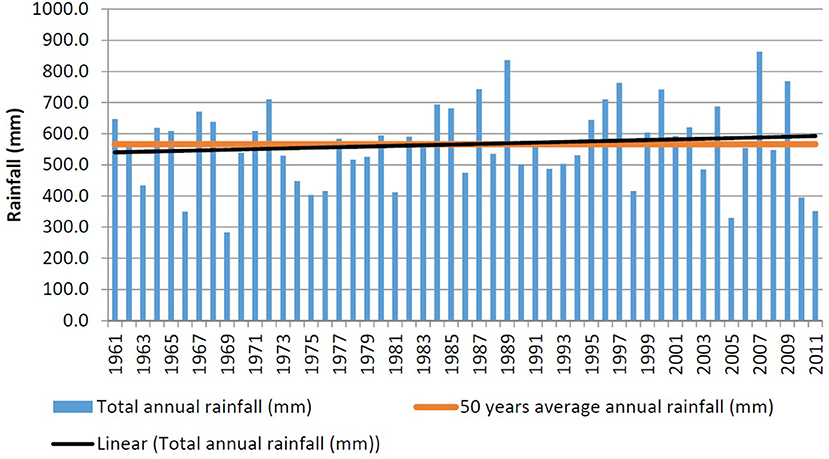
Figure 2. Long-term (1961−2011) annual rainfall for Dodoma (data source: Tanzania Meteorological Agency).
Vulnerability to Water Shortage for Domestic Use and Livestock
The prolonged droughts during 2007–2011 resulted in the drying of rivers, water ponds, and traditional wells. Combined with unreliable water sources (e.g., pumped borehole) for villages such as Nhinhi in Chamwino, this led to increased commuting distance and hours to domestic water supply points, higher cost per unit of domestic water from local water vendors, and increased distance to livestock drinking water points (Table 3). In Chamwino, the villagers commuted between 2 and 6 km for 2–10 h to collect water for household domestic use. The inadequate supply at the water sources forced them to queue for many hours in order to fetch water. Women and girls in the households spent these long distances and hours because fetching of water for household domestic use is their responsibility in most African cultures, including in the study area. The Mtera hydropower dam and villages near to the dam served as alternative sources of water supply to Nhinhi, Fufu, and Chiboli villages. In Mwanga, the longest distance to domestic water source during droughts for Kiruruibweijewa was 11 km. They trekked to Lembeli village where Mohamed Enterprises Limited, a private business company, had installed a pumped borehole to supply water for the community.
In rural areas of Tanzania, community members contribute about 50 Tanzanian shillings for every 20-L bucket of domestic water collected from a community water supply point such as piped water kiosk or groundwater handpump. The contributions are aimed to sustain the operation and maintenance of the water systems under community water supply organizations (World Bank, 2018). In years without drought, traditional water sources provided a reliable supply for domestic uses. The prolonged droughts of 2007–2011 contributed to the increase of the cost of the 20-L bucket of water by 10 times in Chamwino and 10–20 times in Mwanga. The increased cost for domestic water in the study areas attracted the owners of animal-powered equipment, such as donkey-pulled carts, to engage in water collection for selling in the community. The shortage of water and increased cost added a burden to vulnerable households, including those with people who are elderly, diseased, disabled, and female-headed. The villagers experienced up to 7 months of water shortage in some drought years. As a result, a household with an average of four members spent up to Tanzania shillings 420,000 for water during the period. This level of spending for domestic water use was equivalent to 65% of the per capita income for Dodoma region in 2010. However, the majority of the villagers barely attained half of the per capita income of the region because of the high poverty levels among those engaged in agriculture in Chamwino district (Economic Development Initiatives (EDI), 2007). Therefore, the vulnerable households rarely managed to afford the cost of water alone in drought years.
Drought also affected the availability and access to water for livestock. In Chamwino, keepers had to move 11 km with their livestock from their villages to other areas within and outside Chamwino District in search for pasture and water. The long commuting distances for pasture and water negatively affected the livelihoods of livestock keepers and fueled land use conflicts between livestock keepers and the farmers. In Kiruruibweijewa and Kivisini, livestock keepers trekked 15 km to Nyumba ya Mungu dam and Lake Jipe in search for water and pasture.
Vulnerability of Household Food Insecurity
Food security of households in the study villages was negatively affected by prolonged droughts from 2007 to 2011. At Chiboli village in Chamwino, this drought period was preceded by crop pest infestation in 2006/2007 and rainfall failure in the 2007/2008 crop seasons. Crop pests were reported by the villagers to have destroyed 50% of sorghum and millets in farms during 2006/2007. These natural calamities led to food shortages in households, food insecurity, and malnutrition due to failure of crop production for two consecutive seasons. Vulnerable households were affected most by the food insecurity situation. Three secondary drivers of household vulnerability to drought-induced food insecurity were identified through the analysis of data collected through participatory tools (Table 4). The first driver was household or family social condition, which was defined by the presence of elderly, ailing members of the family, and dependence on food handouts. The second was poor-resourced households in terms of ownership of household assets, such as livestock and good agricultural land. Households affected by this driver in some study villages, such as Kiruruibweijewa in Mwanga, were located in environmentally constrained or less resourceful areas (Figure 3). They were constantly in a vicious cycle of food insecurity, practiced seasonal migration to sell labor, and were characterized with the lowest literacy rates. Thirdly is income source, with households sorely depending on rainfed agriculture and labor selling as their main source of income, thus being more vulnerable to food insecurity during droughts. Based on this driver, households of the Gogo ethnic group in Chamwino villages that entirely depended on rainfed agriculture were revealed to be more vulnerable compared to households of Sukuma, Rangi, and Hehe that have diversified income sources.
Ownership of resources, such as fertile agricultural land and livestock, was one of the important elements of the coping strategy of households and resilience building to the effects of droughts. Households with a large herd of livestock were better positioned to cope with food insecurity through sales of animals to obtain money for buying food during droughts. Having a large herd of livestock was important because a drop in livestock prices due to droughts could be compensated by selling more animals to obtain sufficient money to buy food. At Kwanyange Village in Mwanga, a drop in prices by 83% for cattle was reported to occur during the 2009 drought. Households owning large herds of cattle also commanded bigger cultivated areas to maximize crop production through animal power.
Food Insecurity Seasons
The analysis of seasonal calendars in the study villages showed that the villages in Chamwino district experienced food insecurity between July and February. October and November were the difficult months for Nhinhi, while in Chiboli the period from December to February was reported as the difficult insecure period (Table 5). In normal years when average rainfall is received (500 mm), the farmers harvest their crops during March–June, and families would keep harvested food in storage. For Mwanga District, October, November, and December were the critical food insecurity period that coincided with the start of the short rain season (Vuli). Poor rains in Vuli season led to a prolonged period of food insecurity in February and March when the long rain season (Masika) begins. Food insecurity was also experienced at the midst and toward the end of the Masika. This happened when fewer rains were received during the Vuli season.
The three secondary drivers of food insecurity have a linkage to poverty, which, together with the declining production of food crops, exacerbate drought-driven food insecurity in the study villages. Resource and income poverty can contribute to a deadly circle of food insecurity and famine. Globally, an estimated 8.9% of the world population is still hungry because they are poor, whether they experience “shocks” such as drought or civil conflicts (Food and Agriculture Organization of the United Nations, 2020). In the event of shocks, such families are severely affected by hunger. Households with access to resources (e.g., livestock, fertile land) and those with non-farm income sources accounted for <20% of the total households in the study villages (Table 6).
Poor crop production due to drought in the study areas greatly contributed to food insecurity among the vulnerable populations—for example, during the study period, data from the Chamwino District Agriculture Office showed that the district had produced 12,178 tons of food in 2008/2009 crop season, while its annual food requirement was 63,501 tons. The poor production caused a deficit of 51,000 tons, leading to food insecurity of more than 30,000 households in the district. The Integrated Food Security and Nutrition Assessment Report for the 2009/2010 crop season revealed that the Chamwino district had 14% of food-insecure population, compared to Mwanga with only 2%. Although the duration of relief food provision was the same in the two districts, food requirement and the number of people requiring relief in the Chamwino district were higher (Table 7). Poor food crop production drove the vulnerable population to perpetual food insecurity because their coping strategy relied on labor selling, which denied them the opportunity to produce their own food.
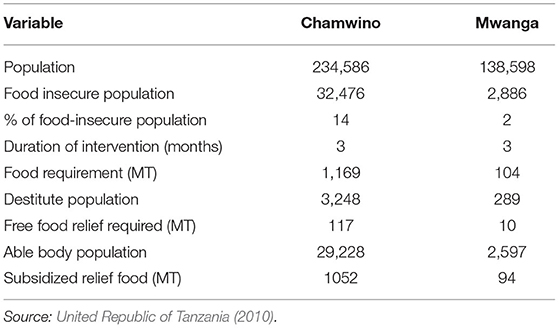
Table 7. Population experiencing food insecurity and food requirement for Chamwino and Mwanga in 2009/2010 crop season.
Coping Strategies to Food Insecurity
Households adopted various coping strategies to drought induced food insecurity (Table 8). In the early stages of drought effects, labor selling to well-off families within the villages, outmigration of male and young household members to nearby districts and regions, and dependence on natural resources, such as charcoal, for livelihood were common both in Chamwino and in Mwanga. In the absence of external support (e.g., food aid), drastic coping strategies were adopted by the affected households. Maintaining one meal per day supplemented with wild fruits and selling of household assets or possessions are some of such strategies. However, most of these coping strategies did not contribute to long-term adaptive and resilient food security systems, while others (e.g., labor selling, selling assets, and natural resource dependence) weakened the production systems of households and drove them into a vicious cycle of food insecurity. They were also considered low paying and not a household resilience builder against future drought-driven food insecurity. Outmigration of male household heads burdened the women with family care, especially when the remittances were not received as expected. Harvesting of forest products, such as charcoal, further weakened the livelihood base of vulnerable households. Charcoal was one of the coping strategies that vulnerable households in all study villages relied upon as an alternative to farm income. Some coping strategies, such as consumption of wild food, were associated with stern consequences of poisoning. Accounts of wild food poisoning incidences included some villagers in Kivisini and miscarriage by a woman in Chiboli after eating wild vegetables. Furthermore, an old man in Chiboli was reported to have fallen down to death from a baobab tree which he had climbed to pick wild fruits.
The government, through the district councils, international NGOs (World Food Programme, International Federation of Red Cross and Red Crescent Societies, World Vision, Oxfam), and faith-based organizations (Catholic, Lutheran, Assemblies of God) working in drought-affected areas provided food aid in the study villages. The aid was provided in the form of (i) food relief to support households facing starvation due to lack of food and (ii) building community resilience to adapt to drought disasters through the provision of agricultural inputs and trainings on crop and livestock production—for example, in 2008/2009, drought-affected households in Chamwino received crop seed varieties from the district council. Unfortunately, the received seeds did not grow because of lack of enough rain. Development organizations and faith-based organizations also supported the affected villages with seeds, fertilizers, and pesticides.
Discussion
Drought is one of the major drivers to water scarcity and food insecurity in rural areas of the central and northern semi-arid areas of Tanzania (Madaha, 2012; Yanda et al., 2015; Mkonda and He, 2018). Their occurrence in these regions, including the study areas presented in this paper, is exacerbated by climate change and climate variability (Mkonda and He, 2018; Zougmoré et al., 2018; Bonatti et al., 2019). The negative consequences encountered by the communities in drought-affected areas include long distance and more time spent to get access to drinking water for domestic use and livestock (Sewando et al., 2016, Velempini et al., 2016), increased cost per unit volume of water for domestic use, prolonged periods of water shortage, eruption of diseases due to lack of water and contamination of limited sources, and food insecurity (Mkonda and He, 2018), leading to hunger and malnutrition.
The nature of gender role distribution forced women to bear the brunt of drought consequences much more severely than men in the study villages (Madaha, 2012). Women culturally take the responsibility of household welfare-related activities, such as collection of water and firewood for domestic use and ensuring food availability on the table, in addition to other main farming and livelihood activities. As such, the work burden for households which have labor constraints forced some children to drop out from schools in order to support parents in making the ends meet in terms of their livelihood (Nganyanyuka, 2017). Women-burdening responsibilities, such as longer hours spent to find water, was one of the sources of family conflicts (Thompson, 2018).
The vulnerability to the effects of droughts was found to be driven by the social conditions of households, resource ownership, and income source. Households with members who have old age, diseases, and physical challenges were more vulnerable to the effects of drought in the study areas. They also experienced malnutrition and dependence on food handouts. These social conditions undermined the cultural values and practices of household, security, social networks and dependence, preparedness strategies, and psychological stress, all of which contribute to social vulnerability to drought (Muyambo et al., 2017). Poor-resourced households were identified in areas that have infertile land for farming, poor natural resources, and long distance from major service infrastructures (e.g., transport). These consequences re-enforced their social vulnerability to drought.
Poverty and income are important drivers of vulnerability. Together with technology, education levels, and availability and quality of infrastructure, they are among the extensively covered vulnerability factors in literature (Hagenlocher et al., 2019). Complete dependence on rainfed farming by poor households increased their vulnerability as droughts affected crop yields, which is the source of income among the farmers. The incomes of farm laborers were also jeopardized as drought curtailed farm activities requiring labor. Almost half of all households engaged in food crop production in eastern Indonesia, and those who relied on agricultural wage labor reported a 30% or more reduction in income due to drought (WFP, 2016). Diversified income sources, such as crop–livestock integration, and investing in non-agriculture income sources at household level were identified by this study as enablers of resilience building to the effects of droughts. Diversification influences asset accumulation, which builds the adaptive capacity of household to drought vulnerability. Sewando et al. (2016) found that diversification of livelihood activities which are less dependent on natural resources improved the adaptive capacity of agro-pastoral farmers in northern and central Tanzania against climate extremes. Studies elsewhere in Tanzania have found that investing into agriculture for smallholders bridges household income disparity, while non-agriculture interventions widen the income disparity gap (Manero, 2017). Thus, interventions that support farmers to develop alternative income sources and build their resilience to drought effects need to be made known to them.
Poor households suffered severely from the impacts of droughts much more than well-off families, forcing extreme compromises, shocks, and hardships. These households were characterized by members with old age, diseases, disability, and widows. Their vulnerability was linked to the social condition they found themselves in, lack of resources to support their livelihoods, and uncertain income sources. Labor selling, outmigration, and natural resource dependence (charcoal making) for household income were the main coping strategies in the early stages of drought effects. Drastic coping strategies, including a reduction of the number of meals per day, consumption of wild food, and dispossession of household assets, were adopted under worse drought situation. However, some of these coping strategies undermined the resource base of the villages, driving into a vicious cycle of vulnerability. According to Sewando et al. (2016), natural asset, by its nature, is more vulnerable to climate shocks than other types of assets.
The failure of traditional livelihood systems in semi-arid arid areas to tolerate drought conditions implies that poor farmers lacking resources to access inputs will remain vulnerable to droughts and subjected to increased food insecurity (Madaha, 2012). Furthermore, the existing development model in the drought-affected areas may have exacerbated the impacts of droughts to the vulnerable households. The study areas are historically recognized as drought prone because of the low annual precipitation received (Mascarenhas, 1977, Velempini et al., 2016). However, the budgetary allocation of the two districts during the study period (2010/2011) was among the lowest out of six and seven districts of Dodoma and Kilimanjaro regions, respectively. Budgets for agriculture and water in Chamwino were second highest and second lowest in allocation. In Mwanga, the two sectors were third and second lowest to be allocated out of seven districts in the region. The budgetary allocations for the two sectors did not reflect their importance for building community resilience against droughts. Inequality in distribution of vital resources is one of the causes of vulnerability to the effects of droughts (Shiferaw et al., 2014; Sewando et al., 2016; King-Okumu et al., 2020). Adaptation measures, including the provision of water supply and sanitation systems (e.g., boreholes), storage of harvested rainwater (e.g., through charco-dams), development of small-scale irrigation infrastructure, and facilitated access to agricultural inputs, are worth implementing in the study areas and others with similar environments to build long-term resilience to drought effects among the vulnerable population.
Conclusion
Prolonged droughts in the central and north-eastern semi-arid areas of Tanzania during 2007–2011 contributed to increased water scarcity and food insecurity of vulnerable rural communities. The consequences of droughts included spending more kilometers, hours, and money for domestic and livestock drinking water by the community members. Both the distance and time spent were far beyond the national water policy prescriptions. Vulnerability to drought-driven food insecurity in the study areas was found to be driven by the social conditions of households, poor resource ownership, and type of income sources. These drivers undermined the social–cultural–psychological values, production assets, and income source diversification. Households with good social condition, relatively resourceful and deriving incomes from crop–livestock integration and non-agriculture, were less vulnerable and therefore better placed to cope with the effects of droughts. Some of the coping strategies that vulnerable households adopted did not contribute to long-term adaptive and resilient productive systems but weakened their household production, perpetuating them into the vicious cycle of food insecurity. The results from this study advocate relevant policies on investments, both by government and development organizations, which builds a productive resource base of vulnerable households in drought-affected areas and improves their year-round access to water for domestic, sanitation, and livestock uses. Such investments will contribute to the building of long-term adaptive and resilience systems to reduce vulnerability, food insecurity, and malnutrition in drought-prone semi-arid areas of Tanzania.
Limitation of the Study
The results of this study are based on data collected through participatory approach and tools, and thus it did not involve a questionnaire survey for the household of drought-affected families. The study findings might have greatly benefited from the administration of a household questionnaire to capture individual household insights that could have been used to disaggregate explicitly the vulnerabilities and coping strategies according to various social groups and expanded the scope of the study. The research is also limited by the inability to compare the status of water resources, agricultural production, etc., in the conditions before and after drought, as the data to support such analysis could not be easily captured during the participatory exercises.
Data Availability Statement
The raw data supporting the conclusions of this article will be made available by the authors, without undue reservation.
Author Contributions
MVM was responsible for the conceptualization, research methodology, data collection supervision, analysis, original draft preparation, and writing and editing. MVM has read and agreed to the published version of the manuscript.
Funding
This study was supported with funding by the Actionaid International Tanzania under the project Social Action Research on Drought in East and the Horn of Africa.
Conflict of Interest
The author declares that the research was conducted in the absence of any commercial or financial relationships that could be construed as a potential conflict of interest.
Publisher's Note
All claims expressed in this article are solely those of the authors and do not necessarily represent those of their affiliated organizations, or those of the publisher, the editors and the reviewers. Any product that may be evaluated in this article, or claim that may be made by its manufacturer, is not guaranteed or endorsed by the publisher.
Acknowledgments
The author acknowledges the efforts of the data collection supervisors and data enumerators in administering the participatory vulnerability analysis tools and collecting the data in the field. The commitment of the villagers from the six study villages to provide information through participatory mapping exercises is also highly acknowledged.
References
Bonatti, M., Borba, J., Schlindwein, I., Rybak, C., and Sieber, S. (2019). They came home over-empowered: identifying masculinities and femininities in food insecurity situations in Tanzania. Sustainability 11:4196. doi: 10.3390/su11154196
Branca, G., Tennigkeit, T., Mann, W., and Lipper, L. (2012). Identifying Opportunities for Climate-Smart Agriculture Investments in Africa. Rome, Italy: Food and Agriculture Organization of the United Nations (FAO).
Chepkoecha, W., Mungai, N. W., Stöber, S., and Lotze-Campen, H. (2020). Understanding adaptive capacity of smallholder African indigenous vegetable farmers to climate change in Kenya. Clim. Risk Manag. 27, 1–13, doi: 10.1016/j.crm.2019.100204
Economic Development Initiatives (EDI). (2007). Survey on Poverty, Welfare and Services in Chamwino District Council, Prime Minister's Office – Regional Administration and Local Governance (PMO-RALG), Dar es Salaam.
Food and Agriculture Organization of the United Nations (2020). The State of Food Security and Nutrition in the World 2020, Rome. Available online at: http://fao.org/documents/card/en/c/ca9692en (accessed May 18, 2021).
Gupta, A., Rico-Medina, A., and Caño-Delgado, A. I. (2020). The physiology of plant responses to drought. Science 368, 266–269. doi: 10.1126/science.aaz7614
Hagenlocher, M., Meza, I., Anderson, C. C., Min, A., Renaud, F. G., Walz, Y., et al. (2019). Drought vulnerability and risk assessments: state of the art, persistent gaps, and research agenda. Environ. Res. Lett. 14:083002. doi: 10.1088/1748-9326/ab225d
Haile, G. G., Tang, Q., Sun, S., Huang, Z., Zhang, X., and Liu, X. (2019). Droughts in East Africa: causes, impacts and resilience. Earth-Sci. Rev. 193, 146–161. doi: 10.1016/j.earscirev.2019.04.015
Kimaro, E. G., Mor, S. M., and Toribio, J. A. L. (2018). Climate change perception and impacts on cattle production in pastoral communities of northern Tanzania. Pastoralism 8:19. doi: 10.1186/s13570-018-0125-5
King-Okumu, C., Tsegai, D., Pandey, R. P., and Rees, G. (2020). Less to lose? Drought impact and vulnerability assessment in disadvantaged regions. Water 2020, 12,1136. doi: 10.3390/w12041136
Liwenga, E. T. (2008). Adaptive livelihood strategies for coping with water scarcity in the drylands of central Tanzania. Phys. Chem. Earth 33, 775–779 doi: 10.1016/j.pce.2008.06.031
Locatelli, B., Herawati, H., Brockhaus, M., Idinoba, M., and Kanninen, M. (2008). Methods and Tools for Assessing the Vulnerability of Forests and People to Climate Change. Working Paper No. 43. CIFOR, Bogor
Madaha, R. M. (2012). Disparate coping strategies for gendered effects of drought A call for re-examination of gender roles and harmful traditions in Central Tanzania. Int. J. Disaster Resil. Built Environ. 3, 283–302. doi: 10.1108/17595901211263675
Manero, A. (2017). Income inequality within smallholder irrigation schemes in Sub-Saharan Africa. Int. J. Water Resourc. Dev. 33, 770–787. doi: 10.1080/07900627.2016.1152461
Mascarenhas, A. C. (1977). Resettlement and desertification: the Wagogo of Dodoma District, Tanzania. Econ. Geogr. 53, 376–380. doi: 10.2307/142977
Mkonda, M. Y., and He, X. (2018). Climate variability and crop yields synergies in Tanzania's semiarid agroecological zone. Ecosyst. Health Sustain. 4, 59–72, doi: 10.1080/20964129.2018.1459868
Mngumi, J. (2016). Perceptions of climate change, environmental variability and the role of agricultural adaptation strategies by small-scale farmers in Africa: the case of Mwanga district in northern Tanzania. PhD thesis. Available online at: http://theses.gla.ac.uk/7441/ (accessed April 15, 2020).
Munishi, L. K., Lema, A. A., and Ndakidemi, P. A. (2015). Decline in maize and beans production in the face of climate change at Hai District in Kilimanjaro Region, Tanzania. Int. J. Clim. Change Strat. Manag. 7, 17–26 doi: 10.1108/IJCCSM-07-2013-0094
Muyambo, F., Jordaan, A. J., and Bahta, Y. T. (2017). Assessing social vulnerability to drought in South Africa: policy implication for drought risk reduction. Jàmbá J. Disas. Risk Stud. 9:a326. doi: 10.4102/jamba.v9i1.326
Nganyanyuka, K. O. (2017). Seeing Like a Citizen: Access to Water in Urban and Rural Tanzania. Twente: University of Twente, Faculty of Geo-Information Science and Earth Observation (ITC).
Oestigaard, T. (2016). “Rainfed agriculture, drought and hunger in Tanzania,” in A History of Water, Series 3, Volume 3. Water and Food: From Hunter-Gatherers to Global Production in Africa, eds. T. Tvedt and T. Oestigaard, 332–354. I.B. Tauris. London. doi: 10.5040/9781350985087.ch-013
Rowhani, P., Lobell, D. B., Linderman, M., and Ramankutty, N. (2011). Climate variability and crop production in Tanzania. Agric. For. Meteorol. 151:449–460. doi: 10.1016/j.agrformet.2010.12.002
Sewando, P. T., Mutabazi, K. D., and Mdoe, N. Y. S. (2016). Vulnerability of agro-pastoral farmers to climate risks in northern and central Tanzania. Dev. Stud. Res. 3, 11–24, doi: 10.1080/21665095.2016.1238311
Shiferaw, B., Tesfaye, K., Kassie, M., Tsedeke, A. T., Prasanna, B. M., and Menkir, A. (2014). Managing vulnerability to drought and enhancing livelihood resilience in sub-Saharan Africa: technological, institutional and policy options. Weather Clim. Extrem. 3, 67–79. doi: 10.1016/j.wace.2014.04.004
Smucker, T. A., and Wangui, E. E. (2016). Gendered knowledge and adaptive practices: differentiation and change in Mwanga District, Tanzania. Ambio 45, S276–S286. doi: 10.1007/s13280-016-0828-z
Temu, A. A., Manyama, C., Mgeni, A., and Langyintuo Waized, B. (2011). Characterization of Maize Producing Households in Manyoni and Chamwino Districts in Tanzania. Country Report—Tanzania. Nairobi: CIMMYT.
Thao, N. T. T., Khoi, D. N., Xuan, T. T., and Tychon, B. (2019). Assessment of livelihood vulnerability to drought: a case study in Dak Nong Province, Vietnam. Int. J. Disaster Risk Sci. 10, 604–615. doi: 10.1007/s13753-019-00230-4
Thompson, L. (2018). The invisible violence that Follows: The Effects of Drought on Children, Kinship, & Gender in Tanzania. Master Thesis, University of Kansas, USA.
Thornton, P. K., Jones, P. G., Alagarswamy, G., and Andresen, J. (2009). Spatial variation of crop yield response to climate change in East Africa. Glob. Environ. Change 19, 54–65, doi: 10.1016/j.gloenvcha.2008.08.005
United Republic of Tanzania (2010). Integrated Food Security and Nutrition Assessment Report of the 2009/2010 Main Season for the Market Year 2010/2011. Final Draft. Tanzania: The Food Security and Nutrition Assessment System
Velempini, K., Smucker, T. A., and Clem, K. R. (2016). Community-based adaptation to climate variability and change: mapping and assessment of water resource management challenges in the North Pare highlands, Tanzania. Afric. Geogr. Rev. 37, 30–48. doi: 10.1080/19376812.2016.1229203
Wangui, E. E., Smucker, T. A., Wisner, B., Lovell, E., Mascarenhas, A., Solomon, M., et al. (2012). Integrated development, risk management and community-based climate change adaptation in a mountain-plains system in Northern Tanzania. J. Alp. Res. 2012, 100–101, doi: 10.4000/rga.1701
WFP (2016). The Impact of Drought on Households in Four Provinces in Eastern Indonesia. Jakarta: World Food Programme.
Wilhite, D. A., and Pulwarty, R. S. (2005). “Drought and water crisis: lessons learned and the road ahead,” in Drought and Water Crisis: Science, Technology, and Management Issues, eds. D. A. Wilhite (New York, NY: Taylor and Francis Group, CRC Press). doi: 10.1201/9781420028386.pt4
World Bank (2018). Reaching for the SDGs: The Untapped Potential of Tanzania's Water Supply, Sanitation, and Hygiene Sector. Washington, DC: WASH Poverty Diagnostic. World Bank.
Yanda, P., Maganga, F., Liwenga, E., Kateka, A., Henku, A., Mabhuye, E., et al. (2015). Tanzania: Country Situation Assessment. Working paper. Pathways to Resilience in Semi-arid Economies (PRISE), University of Dar es Salaam
Zarafshani, K., Sharafi, L., Azadi, H., and Van Passel, S. (2016). Vulnerability assessment models to drought: toward a conceptual framework. Sustainability 8:588. doi: 10.3390/su8060588
Keywords: drought, food security, semi-arid, Tanzania, vulnerability, water scarcity
Citation: Mdemu MV (2021) Community's Vulnerability to Drought-Driven Water Scarcity and Food Insecurity in Central and Northern Semi-arid Areas of Tanzania. Front. Clim. 3:737655. doi: 10.3389/fclim.2021.737655
Received: 07 July 2021; Accepted: 03 September 2021;
Published: 27 October 2021.
Edited by:
Juan Antonio Rivera, CONICET Argentine Institute of Nivology, Glaciology and Environmental Sciences (IANIGLA), ArgentinaReviewed by:
Moses Nyangito, University of Nairobi, KenyaMsafiri Mkonda, Sokoine University of Agriculture, Tanzania
Marzieh Keshavarz, Payame Noor University, Iran
Copyright © 2021 Mdemu. This is an open-access article distributed under the terms of the Creative Commons Attribution License (CC BY). The use, distribution or reproduction in other forums is permitted, provided the original author(s) and the copyright owner(s) are credited and that the original publication in this journal is cited, in accordance with accepted academic practice. No use, distribution or reproduction is permitted which does not comply with these terms.
*Correspondence: Makarius V. Mdemu, bWFrYXJpdXMubWRlbXVAYXJ1LmFjLnR6; bWFrbWRlbXVAZ21haWwuY29t
 Makarius V. Mdemu
Makarius V. Mdemu